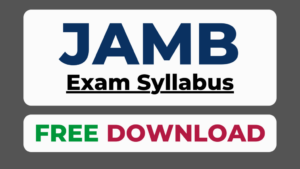The JAMB Syllabus for Chemistry PDF Download is designed to help candidates understand key concepts in chemistry and prepare effectively for the Joint Admissions and Matriculation Board (JAMB) Unified Tertiary Matriculation Examination (UTME). It covers a broad range of topics from fundamental principles to more complex applications of chemistry.

JAMB Syllabus for Chemistry Pdf Download 2025
Below is a detailed breakdown of the topics and subtopics in the JAMB Chemistry syllabus.
Main Topics in the JAMB Chemistry Syllabus
1. Separation of Mixtures and Purification of Chemical Substances
This section focuses on understanding different separation techniques and their applications in chemistry.
- Techniques: Filtration, evaporation, crystallization, distillation (simple, fractional, and steam), chromatography, and separation using magnets.
- Purification: Methods used to purify chemical substances and identify their purity (e.g., melting point and boiling point determination).
Key Focus:
- Understanding the different methods of separating mixtures and their practical uses in the lab.
2. Chemical Combination
- Laws of Chemical Combination: Law of conservation of mass, law of constant composition, law of multiple proportions, and law of reciprocal proportions.
- Chemical Symbols and Formulae: Representation of elements and compounds using symbols and formulae.
- Valency and Chemical Equations: Writing balanced chemical equations, understanding valency, and stoichiometric calculations.
Key Focus:
- Mastering the balancing of chemical equations and stoichiometry.
- Understanding the concept of the mole and molar mass.
3. Atomic Structure and Bonding
- Atomic Structure: Protons, neutrons, and electrons, isotopes, electron configuration, atomic number, and mass number.
- Periodic Table: Arrangement of elements, periodicity, and trends in physical and chemical properties.
- Chemical Bonding: Ionic, covalent, and metallic bonds, hydrogen bonding, and van der Waals forces.
Key Focus:
- Learning how to draw the electronic configuration of elements.
- Understanding the periodic trends such as ionization energy, electronegativity, and atomic radius.
4. States of Matter
- Gases: Gas laws (Boyle’s Law, Charles’ Law, Ideal Gas Law), kinetic theory of gases, and Avogadro’s law.
- Liquids: Properties of liquids, surface tension, viscosity, and vapour pressure.
- Solids: Types of solids (ionic, covalent, metallic), crystalline and amorphous solids.
Key Focus:
- Applying gas laws to solve problems on pressure, volume, and temperature changes in gases.
- Understanding intermolecular forces in liquids and solids.
5. Acids, Bases, and Salts
- Acids and Bases: Properties of acids and bases, pH scale, indicators, and the concept of neutralization.
- Salts: Methods of preparing salts, solubility of salts, hydrolysis of salts, and uses of salts.
Key Focus:
- Performing titration calculations involving acids, bases, and salts.
- Understanding buffer solutions and their applications.
6. Chemical Kinetics and Equilibrium
- Rates of Reaction: Factors affecting the rates of chemical reactions (temperature, concentration, surface area, and catalysts).
- Equilibrium: Dynamic equilibrium, Le Chatelier’s principle, and factors affecting equilibrium.
Key Focus:
- Solving problems related to reaction rates and interpreting energy profiles for reactions.
- Applying Le Chatelier’s principle to predict changes in equilibrium systems.
7. Electrochemistry
- Electrolytes and Non-Electrolytes: Understanding the difference between electrolytes and non-electrolytes.
- Electrolysis: Faraday’s laws of electrolysis, electrochemical cells, and applications of electrolysis (e.g., electroplating).
- Redox Reactions: Oxidation and reduction, oxidizing and reducing agents, balancing redox reactions.
Key Focus:
- Understanding the concept of electrolysis and solving problems related to Faraday’s laws.
- Balancing redox reactions in acidic and basic media.
8. Organic Chemistry
- Alkanes, Alkenes, and Alkynes: Nomenclature, structure, preparation, and reactions of hydrocarbons.
- Functional Groups: Alcohols, carboxylic acids, esters, aldehydes, ketones, amines, and amides.
- Polymers: Addition and condensation polymerization, types of polymers, and their applications.
Key Focus:
- Learning the structure, nomenclature, and reactions of different organic compounds.
- Understanding the applications of organic compounds in daily life (e.g., plastics, detergents, pharmaceuticals).
9. Thermodynamics
- Heat Changes: Exothermic and endothermic reactions, enthalpy changes (ΔH), and Hess’s Law.
- Energy and Chemical Reactions: Calculation of energy changes using bond energies, calorimetry, and specific heat capacity.
Key Focus:
- Applying Hess’s law to calculate enthalpy changes in chemical reactions.
- Understanding the energy changes associated with chemical reactions.
10. Environmental Chemistry
- Pollution: Types and sources of pollutants (air, water, soil), effects of pollution, and control methods.
- Green Chemistry: Concepts of green chemistry and sustainable practices in reducing pollution.
Key Focus:
- Understanding the effects of pollutants on the environment and how chemistry can be used to solve environmental problems.
General Tips for Preparing for JAMB Chemistry
- Understand the Basic Concepts: Chemistry involves understanding basic principles. Make sure you grasp key concepts before moving to more complex topics.
- Memorize Important Formulae and Constants: Learn important formulas and constants, such as the gas laws and Avogadro’s number, which are frequently used in problem-solving.
- Practice Problem-Solving: Chemistry, especially physical and organic chemistry, involves a lot of calculations. Practice solving problems related to chemical equations, stoichiometry, and titration.
- Use Past Questions: Familiarize yourself with the structure and types of questions asked in JAMB Chemistry by practicing past questions.
Recommended Textbooks for JAMB Chemistry
- “New School Chemistry” by Osei Yaw Ababio.
- “Essential Chemistry for Senior Secondary Schools” by O. A. Longe and A. L. Longe.
- “Lambe’s Chemistry Textbook for Senior Secondary Schools” by E.C.C. Lambe.
Jamb Syllabus FAQS
Is the JAMB syllabus different for UTME and Direct Entry?
The JAMB syllabus is primarily designed for UTME candidates. Direct Entry candidates may not need the syllabus as their admission process is based on their A-level or equivalent qualifications. However, some Direct Entry candidates may still find the syllabus useful if they are required to take certain exams.
How do I know if I’m using the correct JAMB syllabus?
Always download the syllabus from the official JAMB website or trusted educational platforms. Ensure the syllabus is for the correct exam year.
Can I combine the JAMB syllabus with past questions?
Yes, combining the JAMB syllabus with past questions is an excellent strategy. It helps you understand the exam pattern and practice questions based on the syllabus topics.
Can I pass JAMB without using the syllabus?
While it is possible to pass JAMB without the syllabus, using it significantly increases your chances of success. The syllabus ensures you cover all the necessary topics and avoid wasting time on irrelevant material.
Are there recommended textbooks in the JAMB syllabus?
Yes, the JAMB syllabus includes a list of recommended textbooks for each subject. These textbooks are aligned with the syllabus and are useful for in-depth preparation.
How can I use the JAMB syllabus effectively?
- Download the syllabus for your chosen subjects.
- Study the recommended textbooks and materials listed in the syllabus.
- Focus on the objectives and topics outlined for each subject.
- Practice past questions related to the syllabus topics
Does JAMB set questions outside the syllabus?
JAMB has stated that all UTME questions are based on the topics outlined in the syllabus. However, some questions may test candidates' critical thinking and application of knowledge.
How many subjects are in the JAMB syllabus?
The JAMB syllabus covers all the subjects offered in the UTME, including:
- Use of English (compulsory for all candidates).
- Science subjects (e.g., Physics, Chemistry, Biology, Mathematics).
- Arts and Social Science subjects (e.g., Literature, Government, Economics, Commerce).
- Other subjects like Agricultural Science, Geography, and Religious Studies.
Is the JAMB syllabus the same every year?
The JAMB syllabus is periodically reviewed and updated. However, changes are usually minimal. Candidates are advised to always check for the latest version of the syllabus for their exam year.
Where can I download the JAMB syllabus?
The JAMB syllabus is available for free on (jamb-portal). You can also find it on other educational websites or platforms that provide JAMB resources.
Why is the JAMB syllabus important?
- It helps candidates focus on relevant topics.
- It ensures candidates are well-prepared for the exam.
- It reduces the chances of studying irrelevant material.
What is the JAMB syllabus?
The JAMB syllabus is an official document that outlines the topics and subtopics candidates are expected to study for each subject in the Unified Tertiary Matriculation Examination (UTME). It serves as a guide to help candidates prepare effectively for the exam.
Conclusion
The JAMB Chemistry syllabus covers a wide range of topics from fundamental principles to more advanced concepts. Candidates should focus on practicing problem-solving, understanding key chemical principles, and applying them in various situations. With consistent revision, use of past questions, and a solid understanding of each topic, candidates can excel in the Chemistry section of the UTME.
